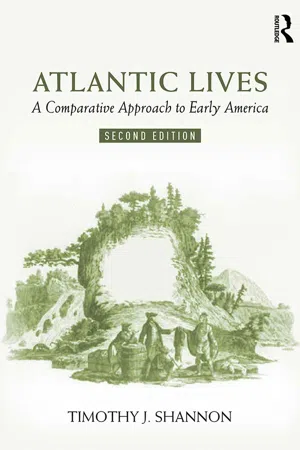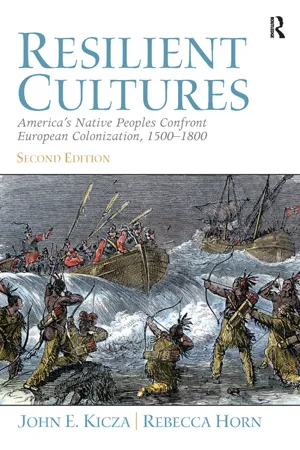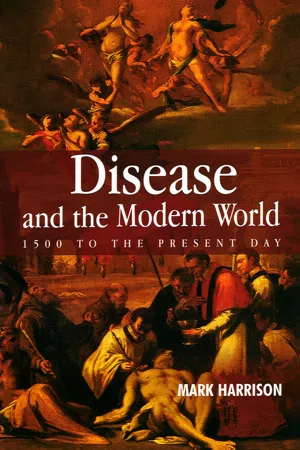Columbian Exchange
The Columbian Exchange refers to the widespread transfer of plants, animals, culture, human populations, technology, and ideas between the Americas and the Old World following Christopher Columbus's voyages to the Americas in 1492. This exchange had a profound impact on both the New and Old Worlds, leading to significant cultural, ecological, and economic changes.
7 Key excerpts on "Columbian Exchange"
- eBook - ePub
World History
An Introduction
- Eric Vanhaute(Author)
- 2013(Publication Date)
- Routledge(Publisher)
...For thousands of years domesticated plants and animals were swapped in Eurasia and North Africa. The rapid acceleration in global contacts after 1500 put these exchanges in a new gear. The ‘Colombian exchange’ marks an important shift in the global history of ecology, agriculture and society. This expression (coined by A. Crosby) refers to the large-scale migration of agricultural crops, cattle species, diseases and cultures between the ‘Old World’ and the ‘New World’ after 1492. This migration of plant and animal species had an immense impact on life in Europe, America, Africa and Asia. Crops that people had never seen became (in time) popular foods: wheat and rice in America, potatoes and tomatoes in Europe, corn and sweet potatoes in Africa and Asia. Very few human societies were not influenced by this large-scale ecological exchange. It transformed the cuisine of regions all over the world. The first European export product – horses – changed the existence of many American Indian tribes on the Great Plains. These plains later became a ‘granary’ of European wheat. Coffee, bananas and sugarcane, originally from Asia, became intensively cultivated crops on Latin American plantations. The new crops also supported social changes in other parts of the world. The modest potato, descendant of a wild and poisonous tuberous plant high in the Andes Mountains, became the cheap, high-calorie basic food of the working class in industrializing Europe. The potato also made accelerated population growth possible. Dependence on this crop became so great that the last European famine in 1845–1848 was caused by failed potato harvests (one million deaths in Ireland, a few hundred thousand in continental Europe). New contacts between the Old and New Worlds also resulted in an exchange of diseases...
- eBook - ePub
A Culinary History of the Chesapeake Bay
Four Centuries of Food & Recipes
- Tangie Holifield(Author)
- 2021(Publication Date)
- The History Press(Publisher)
...CHAPTER 3 Where the African Diaspora Meets the Colonial Crossroads T HE C OLUMBIAN E XCHANGE The food that was eaten at this time was simply what Natives foraged, hunted and grew and what the Europeans brought over that would grow on the Atlantic Coastal Plain. Mid-Atlantic cuisine was not what we conceptualize as it exists today until the Columbian Exchange occurred. The Columbian Exchange refers to the exchange of ideas, food crops, populations and diseases between the New World and the Old World following the second voyage to the Americas by Christopher Columbus in 1493. The Old World, which included Europe and the entire Eastern Hemisphere, benefited from the Columbian Exchange in a number of ways. The discoveries of new supplies of natural resources, like metals such as gold and silver, are perhaps the best known. But the Old World also gained new staple crops, such as potatoes, sweet potatoes, maize and cassava. Less calorie-intensive foods, such as tomatoes, chili peppers, cacao, peanuts and pineapples, were also introduced and are now culinary centerpieces in many Old World countries, namely Italy, Greece and other Mediterranean countries (tomatoes), India and Korea (chili peppers), Hungary (paprika, made from chili peppers) and Malaysia and Thailand (chili peppers and pineapples). The Columbian Exchange changed American foodways in a large sense. This exchange of food, livestock, diseases and humans as commodities created a massive cultural shift in the Americas. Moreover, the changes in agriculture significantly altered and changed global populations. The cultivation of financially lucrative crops like tobacco and sugar in the Americas, along with the devastation of Indigenous populations that were enslaved and died from disease, resulted in a demand for labor...
- eBook - ePub
Atlantic Lives
A Comparative Approach to Early America
- Timothy Shannon(Author)
- 2019(Publication Date)
- Routledge(Publisher)
...2 The Columbian Exchange Figure 2.1 Smallpox among the Nahuatl in Sixteenth-Century Mexico. Of the many diseases transmitted across the Atlantic in the Columbian Exchange, smallpox was the most deadly for Native Americans (see Selection 2). Considered a childhood disease in Europe, in America it led to fatality rates that ranged from 30 to 90 percent of infected populations. This image of Native Americans suffering from smallpox comes from a sixteenth-century Spanish collection about the Aztecs. Source: Florentine Codex, Book XII folio 54. Bernardino de Sahagún, Historia general de las cosas de la Nueva España (1540–1585). Introduction The passage of human beings between the Old World and the New led to a much wider transfer of plant and animal life commonly known as the Columbian Exchange. Some of this exchange occurred by design, such as when Old World farmers planted American crops in their fields; other times, the exchange was inadvertent, such as when colonists unwittingly introduced new diseases to Native American populations. Whether purposeful or accidental, such exchanges forever altered the nature of plant, animal, and human life on both sides of the Atlantic. Formerly isolated ecosystems became intertwined and transformed in the process. Some species experienced extinction or near extinction, while others flourished in new surroundings unchecked by natural enemies. While scholars have typically studied the human actors involved in this drama, we cannot appreciate the full impact of the Columbian Exchange without considering the other forms of life it affected. The most profound changes wrought by the Columbian Exchange resulted from the transmission of microbes from the Old World to the New. European sailors, explorers, traders, and colonists brought to the Americas a number of diseases to which Native Americans had had no previous exposure, and therefore, no natural immunities...
- eBook - ePub
Resilient Cultures
America's Native Peoples Confront European Colonialization 1500-1800
- John Kicza, Rebecca Horn(Authors)
- 2016(Publication Date)
- Routledge(Publisher)
...8 Enduring Connections between the New World and the Old T he preceding chapters have considered the nature of the native peoples of the Americas and how they were affected by and responded to European colonization. The first part of this chapter examines the impact of the incorporation of the Americas into the environmental and economic frameworks of the Old World, a process commonly termed “The Columbian Exchange.” For the first time, the Atlantic Ocean became a primary arena for the movement of people, diseases, animals, plants, and precious metals. This process transformed the environment of the Americas as much as it did the rest of the world. The following five sections consider the scope and impact of each of these emerging connections between the New World and the Old. A concluding section examines certain lasting patterns and trends in the history of Indian–European interactions in the colonial period. Before the discovery of the Americas, Western Europe participated only episodically in the exchange systems of the Old World. Located on the western periphery of the three continents of Africa, Asia, and Europe that constituted this trade zone, Western Europe produced few commodities or manufactured goods that could compete in African or Asian markets. Hence, it scarcely participated in the dynamic and flourishing trading networks centered in the Indian Ocean and the South China Sea. The complex economies of South Asia and China routinely shipped merchandise to East Africa, throughout Southeast Asia, and to the Spice Islands (modern Indonesia) and the Philippines. The Movement of Peoples The Americas had only minimal impact on the Old World in the exchange of people. Few Native Americans journeyed to Europe, and fewer still remained for very long. Europe certainly did not need people from America as settlers or laborers. Early explorers of the Americas, though, frequently kidnapped small numbers of young natives to take back with them...
- eBook - ePub
A History of Global Consumption
1500 - 1800
- Ina Baghdiantz McCabe(Author)
- 2014(Publication Date)
- Routledge(Publisher)
...Famously called the Columbian Exchange by historian Alfred Crosby, the exchange’s impact on the world – both Old and New – continues to this day. The exchange had consequences that none of Europe’s theologians, medical doctors or thinkers could have imagined. Fixed on the idea of Creation, Europeans had to ask the very important question: why did they not know what they were encountering? After 1492, European explorers faced unknown plants and animals. Sensitive to the economic importance of the luxuriant vegetation they encountered, Europeans collected samples of the new goods and thus Spanish galleons brought coconuts, maize, potatoes and chillies back to Seville together with silver and gold. The encounter between Europeans and this new world of food transformed their culinary habits, but did so extremely slowly. Unlike the Chinese, Europeans did not adopt these New World foods with ease. Their resistance to several New World foods was extraordinary. It took Europeans several centuries to culturally integrate foods they viewed as low in the hierarchy of foods they had culturally constructed. 2 Ranking Foods: The Original Food Pyramid, Air, Water, Sky Although initially viewed negatively, chocolate was encountered at the court of American potentates, therefore it was adopted by European courts, but potatoes and tomatoes, mere vegetables, were slow to become part of Europe’s diet. Once they became part of the European diet, the result was a hybrid cuisine that eventually would be seen as Europe’s own national cuisine. 3 Is it possible to imagine southern Italian dishes without tomatoes, German and Belgian dishes without potatoes, or Spanish cuisine without pimenton ? Yet these New World vegetables had difficulty being accepted in the culinary culture of Europe...
- Gregory Feldmeth, Christine Custred(Authors)
- 2015(Publication Date)
- Research & Education Association(Publisher)
...Within 50 years of Columbus’s arrival in the Caribbean, some native tribes on the islands were virtually extinct. On the island of Hispaniola, the population dropped from approximately 1 million to just 500 by 1600. In Peru the population dropped from 9 million in 1530 to 500,000 in 1630. Some historians estimate that in some regions as many as 95 percent of Indian peoples died of European diseases in the first century after contact. In this Columbian Exchange, whites fared much better than Indians. While sexually transmitted diseases were carried by sailors returning to Europe, other New World contributions were of great positive value. New agricultural techniques and new crops, such as tomatoes, potatoes, pumpkins, beans, and squash, enriched European diets. Maize, which Columbus brought back to Spain after his first voyage, became an important part of European diets, as did potatoes. In sum, the contact with European civilizations proved disastrous for the Indian residents of the New World. They were devastated by conquering armies and by disease, and made to work as slaves. While vestiges of their cultures have survived to the present day, most of their traditions, cities, villages, and populations have been wiped out. The Age of Exploration (1492–1607) Excited by the gold Columbus had brought back from America (after Amerigo Vespucci, an Italian member of a Portuguese expedition to South America whose widely disseminated report suggested a new world had been found), Ferdinand and Isabella, joint monarchs of Spain, sought to obtain formal confirmation of their ownership of these new lands...
- Mark Harrison(Author)
- 2013(Publication Date)
- Polity(Publisher)
...4 The World beyond Europe New World peoples, Old World diseases The world that emerged from the Renaissance and the Reformation was a world that looked increasingly to the future. Though scholars and statesmen still revered Classical civilization, they looked forwarded in confident anticipation of progress. They looked increasingly beyond Europe, too. The rise of the West depended very largely on its willingness to seek out, and ultimately to control, new lands, commodities and peoples. 1 In the process, Western medicine was confronted with new challenges and opportunities, in the forms of disease and medicinal plants. And with the movement of peoples came the passage of microbes, hastening what Emmanuel Le Roy Ladurie has described as the ‘unification of the globe by disease’. 2 But while germs were distributed far more widely than before, the burden of disease was far from equal. Long exposure to infections like smallpox and measles gave Europeans an immunity that the peoples of America and the Pacific lacked. In the Old World there were more domesticated animals, which acted as reservoirs of infection, and all the key centres of population had long been joined by trade, which ensured regular mixing of germs. 3 Once Europeans landed in the New World, Old World infections spread rapidly and fatally among the local inhabitants, leaving Europeans relatively unscathed. Spanish censuses and tax surveys suggest that the indigenous population halved within two decades after the first reported epidemics. 4 The best-known account of these epidemics is Alfred W. Crosby’s book, The Columbian Exchange (1972). 5 Crosby argues that the importation of lethal pathogens was one aspect of a process of ‘ecological imperialism’ that allowed white settlers rapidly to attain dominance over Native Americans. 6 Without the advantage conferred by disease, he insists, the Spanish would never have been able to overcome the militaristic civilizations of Mexico and the Andes...






